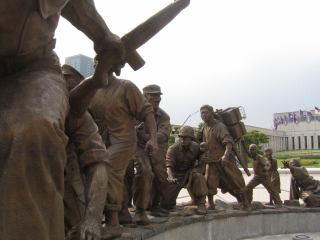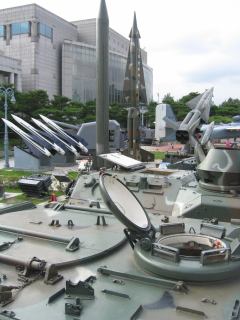We weren’t planning to visit the Demilitarized Zone, but we were told it was the thing to do in South Korea. I expected to simply peer across the ceasefire line from a safe and secure concrete bunker instead of crossing the ceasefire line in an area where North Korean soldiers may enter at any moment.
I felt pretty safe throughout the experience. When we entered the UN building that crossed the ceasefire line there were two guards covering the door on the North Korean side. We only saw one North Korean far in the distance but were advised that the North Koreans were watching from the guard towers.
Tourists are photographed by The North for propaganda, so conservative dress was required and communicating with North Korean soldiers was not allowed in any way, including pointing, gesturing or making faces. The intimidation factor is interesting: the Republic of Korea soldiers (ROC soldiers) wear tinted glasses as part of the standard uniform and have ball bearings sewn into the cuff of their trousers so that when they march, it sounds like a larger contingent.
We did stop at a couple of safe lookout points later. One had a good view of what the South Koreans call Propaganda Village, a constructed set of homes and apartment buildings which try to make The North look prosperous. We were told that no one lived there and the four story buildings did not even have floors. The village had one of the largest flag poles and flags in the world. The flag weighs over 600 pounds when dry. It has to be taken down in bad weather and must be replaced four times a year because it starts to tear under it’s own weight.
The other lookout was much larger and is outside the DMZ. A large amphitheater faced a wall of windows which looked far into North Korea. South Koreans go to this observatory on holidays to think about relatives who are still in The North. We could see the Kaesong Industrial Complex where South Korean companies are working with the North in a goodwill program.

After the DMZ, I returned to the War Memorial and Museum with Janet. She hadn’t been interested in going the first time, but my enthusiastic descriptions brought us back. The main building houses a museum and a list of the people who died in the war, including a small section for Canadians.

Artillery and vehicles from the last 50 years cover the surrounding grounds. Most were from the Korean and Vietnam wars, but there was also a SCUD missile recovered during the Gulf War. In places there are so many missiles and tanks one can hardly tell where one ends and the next starts.


